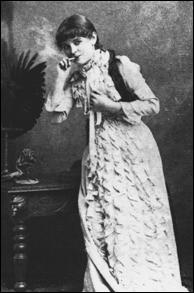
Dominic Vautier 1/7/2011
Stores and mail order houses began to
stock an endless supply of goods. There
were 8,000 cars on the road, 10 million bicycles, and 18 million horses
and mules. 1.3 million
telephones were in service. Tobacco
makers produced over 4 billion cigarettes, but women were still not
allowed to smoke in public, although many women continued to flout the
law and take do it anyway.
Harry Von Tilzer wrote a song about a girl who married for money, probably not the first time. The song went over very big and brought tears to the eyes and sadness to the hearts of millions of women. The first big song hit of the new century was Bird in a Gilded Cage.
The country finally went on a gold standard. W. J. Brian was right all along.
Belle Archer, 1891, by Benjamin Falk was an example of the new woman. She was considered “fast”, a vulgar term for a lady who was disrespectful, flippant and smoked.
New York City got its autobuses to regularly run on Fifth Avenue. It cost 5 cents. They ran quietly on electricity, held 12 passengers, and did not scare the horses.
John Luther Jones died in a locomotive accident near Vaughn Mississippi. He was late and going way too fast. Nobody really noticed it then but 9 years later everybody would.
U.S. Forces help crush Boxer Rebellion.
Carrie Jacobs Bond became the first woman to open her own music publishing business. She not only published but also wrote her own music. She had two songs that sold over a million copies during a successful career as songwriter and publisher, I Love You Truly and A Perfect Day.
Frank Baum published The Wonderful World of Oz.
George Eastman marketed his $1 Brownie.
President McKinley was shot by anarchist Leon Czolgosz (zol-gotz), who confessed that he believed the government needed to be changed. Leon got his way because McKinley died eight days later.
Broadway now had 41 theaters. London had 32 while Paris had only 24.
After serving two and a half years for embezzlement, O. Henry got out of prison and made his way to New York.
Hello, Central, Give Me Heaven was a song about a little girl who tried to talk to her dead mother on the telephone. Chuck Harris wrote the song and got even richer. The telephone was used a lot in business but the average home was still without one. You usually called the corner drugstore and they would send a runner to find the party.
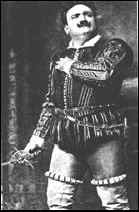 Henry Caruso
Henry Caruso
Henry Caruso was the first opera singer to make a record. He made them on disks because the cylinder required him to sing over and over again. With the Berliner process, he only had to do it once.
Bill Bailey was big, and probably did come home.
Harry Von Tilzer wrote his famous beer hall song Down Where the Wurzburger Flows and all the Germans loved him for it. Beer sales improved.
Jell-O hits the markets.
It was a good summer for In The Good Old Summer Time.
The Entertainer, a classic ragtime song by Scott Joplin enjoyed some success. The song was revived in 1972 and used as the theme song for the movie The Sting.
The model A Ford sold for $850.
This was the year of the first truly
American Musical Babes in Toyland;
a story of a couple of shipwrecked kids washed up on the shores of a
fabulous
The Wright brothers’ machine took to the skies. Nobody noticed it or even believed it. In fact the Smithsonian steadfastly proclaimed for many years that their own director Langley was the first to fly, but Langley just splashed.
The Great Train Robbery was released. It was the first movie with a story.
The Quaker City Four did Sweet Adeline and Boston was never the same.
 The
fabulous amusement park Dreamland opened at Coney Island. Along with
Luna Park
and Steeplechase Park, these three entertainment centers were without doubt the envy of the
entire world. A few years
after the opening of Dreamland came the song Meet
Me Tonight in Dreamland which described two lovers’ clandestine
meeting at the amusement park. This
slow waltz was the most successful song ever written up until that time
quickly selling 5 million copies.
The
fabulous amusement park Dreamland opened at Coney Island. Along with
Luna Park
and Steeplechase Park, these three entertainment centers were without doubt the envy of the
entire world. A few years
after the opening of Dreamland came the song Meet
Me Tonight in Dreamland which described two lovers’ clandestine
meeting at the amusement park. This
slow waltz was the most successful song ever written up until that time
quickly selling 5 million copies.
The musical extravaganza Mr. Bluebeard opened staring Eddie Foy. In December it was playing at the Iroquois Theater in Chicago when someone shouted “FIRE.” A panic followed and 600 people were trampled to death because the doors to the theater opened the wrong way. This terrible tragedy caused all the fire laws in the country to be updated, and all the doors to open outward.
The Society of American Piano Manufacturers burned a huge pile of square pianos at their convention in Atlantic city.
A snappy little ragtime number by Harry Von Tilzer hit the charts called Good-bye, Eliza Jane.
A woman in a motorcar was arrested for smoking in public. “You can’t do that on Fifth Avenue!” Said the policeman. Even the president’s own daughter Alice herself had been seen smoking in public. A disturbing trend was that more and more women were brazenly taking the initiative and smoking in clear view of everybody, even men.
This was the year of the St. Louis World’s Fair, or more properly, the Louisiana Purchase Exposition.
It featured the introduction of ice cream, the hamburger, iced
tea, the roller-coaster, and again of course, Little Egypt (the
Hootchy-kootchy girl), left over from Chicago's World Fair 10 years
before, and just as sensational. The
fair also featured a display of more than 100 automobiles that had been
driven all the way from New York.
Roosevelt was elected to his own term.
George M. Cohan produced Little Johnny Jones featuring such hits as Give My Regards to Broadway and I Am the Yankee Doodle Boy.
All Off-Broadway theaters seated 299 people because a law was passed requiring an amusement license if they seated 300 or more.
Goodbye, My Lady Love becomes popular and so did The Preacher and the Bear. The recorded version of this second song was to be the first million-seller record, although it would take ten years to do it.
The Hippodrome opened at Luna Park with a seating capacity of 5200. It featured a huge swimming tank 14 feet deep. The fabulous facility, which cost more than 2 million dollars to build, was finally closed in 1935 after an illustrious career.
The first pizza appeared. Gennaro Lombardi featured this new and unusual food in his restaurant on Spring Street in New York City. It was supposed to be a specialty from Naples, but nobody in Naples had ever heard if it.
Nickelodeons were the rage. You were able to see a 10-minute flicker, a short vaudeville act, and a soloist perform, all for a nickel. This immoral amusement had begun to spread from Yew York to other cities.
Sally was Paul Dresser’s girl friend so he wrote a song about her called My Gal Sal. Then he died.
Harry Von Tilzer blew away the competition with two great songs this year, Rufus Rastus Johnson Brown and Wait ‘til the Sun Shines, Nellie.
San Francisco was ravaged by earthquake and fire.
President Roosevelt’s daughter got married. “I can do one of two things,” the president once said. “I can be president of the United States, or I can control Alice. I cannot possibly do both.” The president’s headstrong daughter had previously been seen at one time racing about in an automobile in the company of three strange men. She had also been reported smoking in public.
Sarah Bernhardt said farewell to America after a most successful tour.
Reginold Fessenden transmitted the first music eight miles.
Anchors Aweigh hit the charts.
Waiting at the Church became the byword.
There she was, waiting at
the church,
Waiting at the church,
Waiting at the church.
And then she found,
He’d left her in the lurch.
Boy, how it did upset her.[1]
George M. Cohan’s You’re a Grand Old Flag makes it to the big time.
On the opening night of Mam’zelle Champagne, noted millionaire Harry Thaw shot and killed the famous architect Stanford White[2] because of White’s long love affair with Mrs. Thaw who went by her stage name Evelyn Nesbit.[3] Stanford White indeed had an eye for beauty, architectural and otherwise. The show was a sellout thereafter, although the seat that White was using was never used again.
Rumor has it that Evelyn
Nesbit was
Used as a model for the Gibson Girl
A new washing machine that ran on electricity was marketed by the Hurley Machine Company of Chicago. Their main competition was the Maytag Pastime which used a hand crank. You could pass the time on the hand crank.
Neiman-Marcus opened in Dallas.
The sensuous novel Three Weeks was banned in Boston. The novel, written by Elinor Glyn was a steamy story about an adulterous Balkan queen who had a passionate three-week affair with a young man. In the book Glyn made lurid, obscene, and obvious references to sex as “it.”
General electric invented the tungsten filament. It gave much better light and used less power--a vast improvement over pig bristles.
 The
first Ziegfeld Follies opened
in the Jardin de Paris. Actually
it was better known as the roof of the New York Theater. Since Ziegfeld was superstitious he called his show the Follies of 1907 which contained 13 letters. It wasn’t until 1911 that he was bold enough to tempt fate and
call it the Ziegfeld Follies.
By this time Florenz Ziegfeld had set the standard for beauty. The perfect female body was 36-26-38.
His follies girls were paid a staggering $75 a week to perform.
They were all 36-26-38.
The
first Ziegfeld Follies opened
in the Jardin de Paris. Actually
it was better known as the roof of the New York Theater. Since Ziegfeld was superstitious he called his show the Follies of 1907 which contained 13 letters. It wasn’t until 1911 that he was bold enough to tempt fate and
call it the Ziegfeld Follies.
By this time Florenz Ziegfeld had set the standard for beauty. The perfect female body was 36-26-38.
His follies girls were paid a staggering $75 a week to perform.
They were all 36-26-38.
School Days sold 3 million copies in a very short time. William Cobb and Gus Edwards get rich in a very short time.
This was the first year that anybody, anytime was actually able to show bare legs on stage. It occurred during the scandalous bathing girl chorus from The Follies of 1907. Although the girls showed their bare legs only up to the knees, it was definitely a movement in the right direction.
The all time favorite barbershop quartet song Sweet Adeline was still going strong. Barbershop music was in its heyday.
The Indian Intermezzo had taken flight with Red Wing.
For some reason this year produced songs that are still with us today. As popular music goes, it was an average year yet many of the songs got stuck in the groves. These songs included, Take me Out to the Ball Game, Shine on Harvest Moon, Sweet Violets, and Cuddle up a Little Closer. Other popular songs that were just as good didn’t make immortality at all, such as Love is like a Cigarette, and In the Garden of My Heart. The judgment of time is sometimes so fickle.
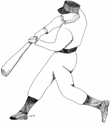 The
scandalous film The Widow Jones with
its licentious 20-second kiss provoked howls of indignation and disgust
from outraged viewers. Action
by the Society for the Prevention
of Crime convinced mayor McClellan of New York to revoke the
licenses of 550 theaters until such time as they stop showing movies on
Sundays and definitely stop showing immoral films altogether, such as The
Widow Jones.
The
scandalous film The Widow Jones with
its licentious 20-second kiss provoked howls of indignation and disgust
from outraged viewers. Action
by the Society for the Prevention
of Crime convinced mayor McClellan of New York to revoke the
licenses of 550 theaters until such time as they stop showing movies on
Sundays and definitely stop showing immoral films altogether, such as The
Widow Jones.
After the Happy Birthday song, Take me out to The Ball Game is the second most performed song in the country today. Albert Von Tilzer and Jack Norworth, who wrote the song together, had no idea what baseball was. Possibly for that reason, the song was done in a slow waltz time which seems strangely at odds with the razzle-dazzle and hustle-bustle of baseball. Nevertheless at many ball games during the seventh inning, this nostalgic slow waltz is played and everybody knows the words. Twenty years after writing the song, Albert Von Tilzer finally decided to see his first ball game.
The international Paper Company developed a paper cup that was so strong that you could use it and just throw away afterwards. The throwaway society had arrived.
General motors came into existence.
Ford built its first model T.
Nora Bayes, considered the most famous vaudevillian of the time, made her Ziegfeld Follies debut with her unique rendition of Shine on Harvest Moon. She had a husky contralto that people described as no less than hypnotic. The next year Ziegfeld wanted her to make her appearance on stage riding an elephant. That was too much so she never came back.
Jack Johnson beat Tommy Burns handily and became the first black heavy weight boxing champion of the world.
Taft beat Brian. Taft just carried a lot more weight. Besides Brian had to carry that cross of gold.
Peary went as far north as he could go.
John Luther Jones’ story finally was told nine years after his train wreck. The song Casey Jones, The Brave Engineer stormed the charts. Casey’s widow didn’t like the line “got another papa on the Salt Lake Line” and sued for damages. She won.
Tin Pan Alley finally got a name, Tin Pan Alley. Many versions of how this happened can be found, but most likely it was named by none other than Harry Von Tilzer in a conversation he had with Monroe Rosenfeld, who was then working as a newspaper reporter. Monroe commented how the whole place sounded like a bunch of tin pans because composers had the habit of stuffing newspapers into their pianos to muffle the sound. Harry was said to remark, “Ya, kinda’ like a tin pan alley.”
I Love my Wife but Oh you Kid puts a new slant on romantic relationships inside and outside of marriage.
Let Me Call You Sweetheart and Meet Me Tonight in Dreamland had by this time together sold over 10 million copies.
The First wireless telegraph press message is sent.
Four women cross the United States by motor car in two months.
More Indian Intermezzos come From the Land of Sky Blue Waters.
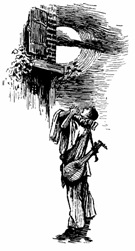
Lillian Lorraine made her Follies debut. She was considered the most beautiful woman in the world.
By the Light of the Silvery Moon became an instant hit even before it was published. Gus Edwards and Edward Maddan put together this classic. They had a feeling they were going to make some money. Jerome Remick, the big publisher, who was in the audience when the song was first performed, immediately offered the songwriter, Gus Edwards $7000 on the spot for rights to the song. $7000 was a lot of money. Gus had found out before hand that Remick had already ordered 1000 copies of the song, so he know that Remick was eager to get rights to publish it. So Edwards asked for $20,000 and got it.[4]
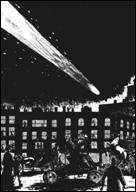
Halley’s comet caused thousands to panic. Comet pills were selling briskly as the comet approached closer to earth. These pills apparently had a special resistance to the poison gas that was inside the tail of the comet. In Chicago people boarded up their windows. In New York, a brick fell on a trolley car, causing the occupants of the car to bail out in panic.
This was the greatest year for sheet music, which is said to have sold over two billion-copies, each at an average price of 30 cents. That’s enough to supply every man, woman and child in the country with 22 copies each. Never again would sheet music sales be this high. In just a few years the market was to collapse.
Fanny Brice joined the Ziegfeld Follies. This was the beginning of a relationship which was to last for 18 years.
Let Me call you Sweetheart was the big hit of the day.
Frederick Taylor became the father of scientific management. From here on in, managers become Dilbertized.
Cadillacs no longer required a hand crank start. Charles Kettering developed a battery-powered starter for the car. Now women and older men can own a Cadillac.
 Considered
by many the greatest of all entertainment centers ever developed, the
fabulous amusement park Dreamland at Coney Island burned to the ground.
Fire broke out on the frightening “hell-gate” ride and
quickly spread throughout the park, soon reducing it to a pile of
cinders. Dreamland was never
rebuilt. Instead the land
was cleared and used for other amusements, circus shows, and various
curiosities. Dreamland was
originally dedicated to finer artistic tastes but it was never as
successful as Luna
Park
or
Steeplechase
Park.
Considered
by many the greatest of all entertainment centers ever developed, the
fabulous amusement park Dreamland at Coney Island burned to the ground.
Fire broke out on the frightening “hell-gate” ride and
quickly spread throughout the park, soon reducing it to a pile of
cinders. Dreamland was never
rebuilt. Instead the land
was cleared and used for other amusements, circus shows, and various
curiosities. Dreamland was
originally dedicated to finer artistic tastes but it was never as
successful as Luna
Park
or
Steeplechase
Park.
Ada Jones and the American Quartet went flying off into the air with their recording of Come Josephine in My Flying Machine. It had been written the previous year by Brian and Fisher and had enjoyed very successful sheet music sales. It was to have even more successful record sales.
Irving Berlin dazzled the world this year with his slow starting Alexander’s Ragtime Band, a song that re-invented ragtime. The recording industry followed the sheet music with recordings by Murray on Edison and Collins on Victor. This song introduced a new popular style with the a 32-measure chorus. Ragtime was back.
The first film studio was established in0 Hollywood. The Nester Company had rented an old tavern, shut down by temperance enthusiasts to set up the first movie studio in California. More was to come.
Things are a cinch. When a young man treats a lady to a Sunday then it’s peachy. If you know someone who wares fancy clothes then it’s flossy. And don’t be peeved if you are called a lowbrow. And that you look lousy. Sure. Just beat it to a movie. Then take a joyride in your friend’s speedy automobile. What a corker that would be.
The Titanic sank.
Irving Berlin wrote When I Lost You, a tribute to his dead wife Dorothy. She had tragically been taken by malaria during their honeymoon. He never really got over it.
Jim Thorpe, the incredible Native American won four gold medals at the Stockholm Olympics.
Finally a democrat, Woodrow Wilson was elected president on a peace platform.
Vernon and Irene Castle
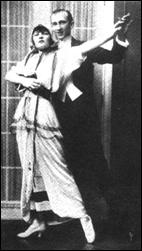 America
was going back to the farm with the introduction of the Turkey Trot, a fast one-step by which the participants flapped their
arms like wild turkeys. This
revolutionary dance came from the Bowery where there were lots of
turkeys. But then didn’t everything come from the Bowery.
America
was going back to the farm with the introduction of the Turkey Trot, a fast one-step by which the participants flapped their
arms like wild turkeys. This
revolutionary dance came from the Bowery where there were lots of
turkeys. But then didn’t everything come from the Bowery.
Vernon and Irene Castle introduced the Castle Walk, the first officially recognized ragtime dance.
Harry Von Tilzer as usual struck gold with Last Night Was The End of the World.
Record sales continued to climb. The Victor Company became a dominant force in the emerging record industry.
This was the year of the dance. New York City had more dance halls than ever before.
There was a higher incidence of broken ankles this year. It was largely attributed to an Argentine invasion called the Tango, a dance that required one to exercise incredible leg flexibility. But there was only one reported case of death by tango. This occurred after a young man had danced for seven straight hours, only to collapse and die on the trolley going home. People felt there should be laws passed outlawing “the dip” as the dance was first called.
5000 women suffragettes marched in Washington DC.
Good-bye Boys hit the top of the charts. It was the last golden song that Harry Von Tilzer would ever compose. From his musical pen had come such an amazing assortment of million selling songs, that no other composer could ever have matched, with the possible exception of Irving Berlin. But Berlin belonged to another generation. Some say that Harry Von Tilzer may have composed as many as 1000 songs during his 15 years as top dog of the Alley. He had at least 15 songs that sold a million copies, an accomplishment that nobody else could even come close to.
Everybody was pegging out and swinging to Peg ‘o My heart.
Billboard Magazine began publishing a list of sheet music best sellers. It would soon switch to records.
Advertisement
in
The New York Times

Harry Fox with the support of the Dolley Sisters began performing a new dance at the Jardin De Dance, (the roof of the New York Theater). The dance quickly came to be called after its namesake. The Fox Trot was considered one of the most significant developments in ballroom dancing.
Ford offered workers $5 a day.
Archduke Ferdinand lost his way and his life in Serijevo. He took a turn for the worse. War began in Europe.
Tangos were forbidden at the Yale Junior Prom. Harvard immediately announced it would Tango all night.
St. Louis Blues was the country’s first hit blues song. It easily sold 1 million copies. W.C. Handy was tooting his horn.
Record sales exceeded sheet music. America was turning the page and on its way to a love affair with the recorded music which was to last a very very long time.
Tin Pan Alley had changed too. Harry Dacre was dead, along with Paul Dresser, Bonnie Thornton and Gussie Davis. Other songwriters had simply retired, got rich, given up, or lost their ability to compose. The greatest of all of them, Harry Von Tilzer would never again produce another million-seller. The face and mood of music was no longer the same. Younger, hungrier, more aggressive composers were now taking over; composers who better understood what people wanted to hear.
Faster dances were everywhere: Fox Trots, Tangos, Mambos, Rumbas. A new freedom was in the offing, which came to fruition in the next decade. The slow American waltz was disappearing.
The First World War accelerated fashion changes. In just 5 years, by 1920 hemlines were up to the knees. It took 30 years to get 2 inches off hemlines. It took just 5 years to get 12 inches. that's progress.
Music became far less censored. “It” was sung about openly.
In an astonishing move, the
“Original Dixieland Jazz Band” moved to
Here are some other links in this article:
Origins of Early Popular Music
Minstrelsy
Broadway
Vaudeville
Other sources
People Growth - the First Baby Boom and it's effect
[1]
Leigh & Pether, Waiting at
the Church, 1906.
[2]
Thaw was brought to trial, where he pleaded insanity and was sent to
a sanitarium. He escaped
in 1914, and was never captured.
[3]
White was not the only one taken in by Evelyn Nesbit’s beauty.
Charles Dana Gibson, the well known cartoonist, used her as a
model for his Gibson Girl.
[4]
Jack Burton, The Blue Book of
Tin Pan Alley, (New York, Century House, 1951), 84.